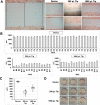An effective device to enable consistent scratches for in vitro scratch assays
- PMID: 37641063
- PMCID: PMC10464081
- DOI: 10.1186/s12896-023-00806-5
An effective device to enable consistent scratches for in vitro scratch assays
Abstract
Background: The in-vitro scratch assay is a useful method in wound healing research to assess cell migration. In this assay, a scratch is created in a confluent cell layer by mechanically removing cells through manual scraping with a sharp-edged tool. This step is traditionally done with pipette tips and is unsuitable for high-throughput assays, as the created scratches are highly variable in width and position. Commercially available solutions are often expensive, and require specific cultureware which might not be suitable for all studies.
Results: In this study, we have developed a flexible cell scratch device comprising a single wounding tool, a guide and an imaging template for consistent and reproducible scratch assays in 96-well plates. Our results showed that the device produced a more consistent scratch profile compared to the conventional method of using pipette tips. The imaging template also allowed operators to easily locate and image the same region of interest at different time points, which potentially could be used for other assays.
Conclusions: Our flexible yet effective scratch device thus enables robust scratch assays that can be applied to different experimental needs, providing researchers with an easy and reliable tool for their studies.
Keywords: Cell migration; Device; Prototype; Scratch assay; Wounding healing.
© 2023. BioMed Central Ltd., part of Springer Nature.
Conflict of interest statement
The authors declare no competing interests.
Figures




Similar articles
-
A cost-effective tool to standardize the scratch assay for cell migration.Biol Cell. 2024 Oct;116(10):e2400061. doi: 10.1111/boc.202400061. Epub 2024 Aug 16. Biol Cell. 2024. PMID: 39151164
-
Lab-made 3D printed stoppers as high-throughput cell migration screening tool.SLAS Technol. 2022 Feb;27(1):39-43. doi: 10.1016/j.slast.2021.10.003. Epub 2021 Oct 25. SLAS Technol. 2022. PMID: 35058201
-
An Experimental Device with Different Widths for Wound Healing Assay.Cells Tissues Organs. 2025;214(3):185-193. doi: 10.1159/000542051. Epub 2024 Oct 15. Cells Tissues Organs. 2025. PMID: 39406194
-
Therapeutic candidates for keloid scars identified by qualitative review of scratch assay research for wound healing.PLoS One. 2021 Jun 18;16(6):e0253669. doi: 10.1371/journal.pone.0253669. eCollection 2021. PLoS One. 2021. PMID: 34143844 Free PMC article. Review.
-
An accurate and cost-effective alternative method for measuring cell migration with the circular wound closure assay.Biosci Rep. 2018 Oct 31;38(5):BSR20180698. doi: 10.1042/BSR20180698. Print 2018 Oct 31. Biosci Rep. 2018. PMID: 30232234 Free PMC article. Review.
Cited by
-
Fabrication of novel nanofiber composed of gelatin/alginate with zirconium oxide NPs regulate orthodontic progression of cartilage degeneration on Wnt/β-catenin signaling axis in MC3T3-E1 cells.Regen Ther. 2024 Feb 2;25:308-319. doi: 10.1016/j.reth.2024.01.004. eCollection 2024 Mar. Regen Ther. 2024. PMID: 38327718 Free PMC article.
-
Development and functional testing of a novel in vitro delayed scratch closure assay.Histochem Cell Biol. 2024 Sep;162(3):245-255. doi: 10.1007/s00418-024-02292-y. Epub 2024 May 7. Histochem Cell Biol. 2024. PMID: 38713267 Free PMC article.
-
Dexketoprofen-Loaded Alginate-Grafted Poly(N-vinylcaprolactam)-Based Hydrogel for Wound Healing.Int J Mol Sci. 2025 Mar 26;26(7):3051. doi: 10.3390/ijms26073051. Int J Mol Sci. 2025. PMID: 40243670 Free PMC article.
-
Brucea Javanica Oil Emulsion Injection inhibits proliferation of pancreatic cancer via regulating apoptosis-related genes.Am J Cancer Res. 2023 Nov 15;13(11):5047-5064. eCollection 2023. Am J Cancer Res. 2023. PMID: 38058798 Free PMC article.
-
A programmable platform for probing cell migration and proliferation.APL Bioeng. 2024 Oct 29;8(4):046106. doi: 10.1063/5.0209547. eCollection 2024 Dec. APL Bioeng. 2024. PMID: 39479200 Free PMC article.
References
-
- Pastar I, Liang L, Sawaya AP, Wikramanayake TC, Glinos GD, Drakulich S, et al. Preclinical models for wound-healing studies. In: Marques AP, Pirraco RP, Cerqueira MT, Reis RL, editors. Skin Tissue Models. Academic Press; 2018. p. 223-253. 10.1016/B978-0-12-810545-0.00010-3.
-
- Rodriguez LG, Wu X, Guan JL. Wound-healing assay. Methods Mol Biol. 2005;294:23–29. - PubMed
Publication types
MeSH terms
LinkOut - more resources
Full Text Sources

